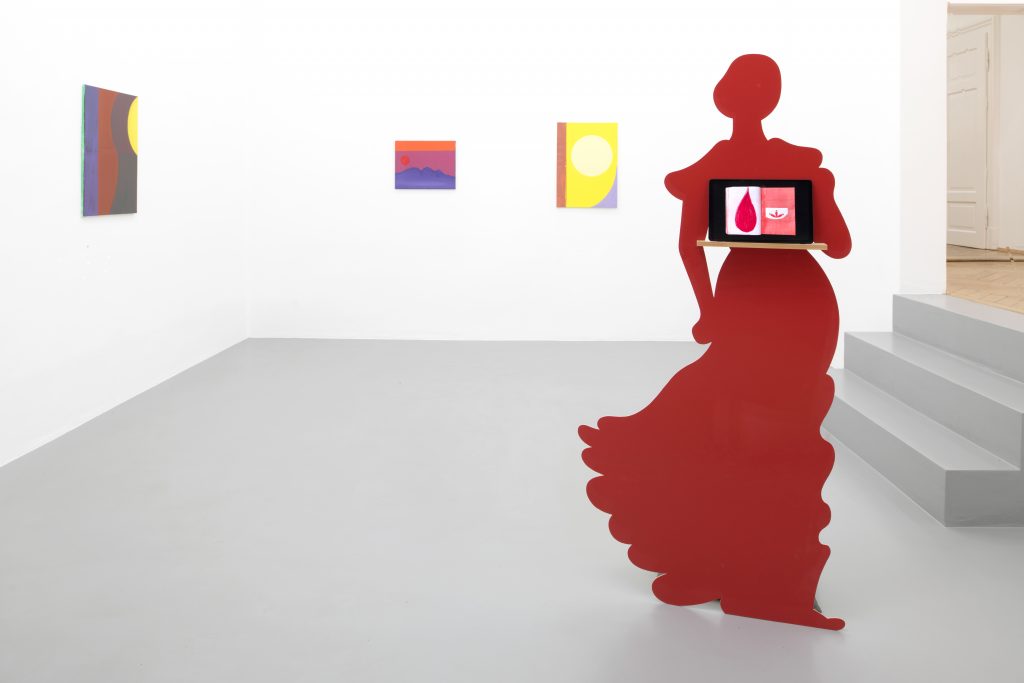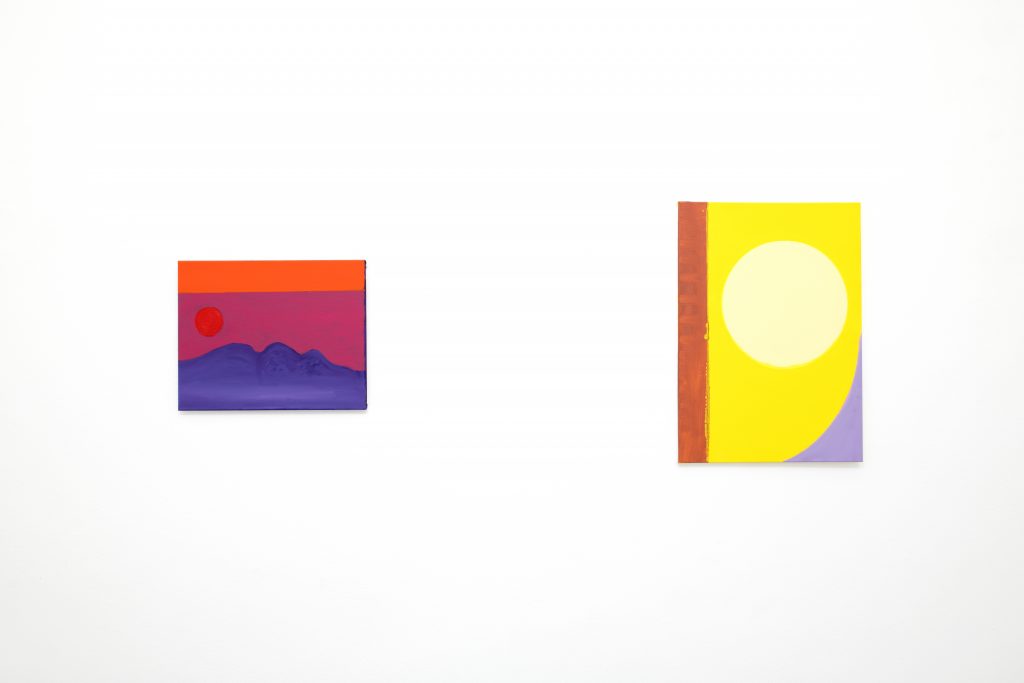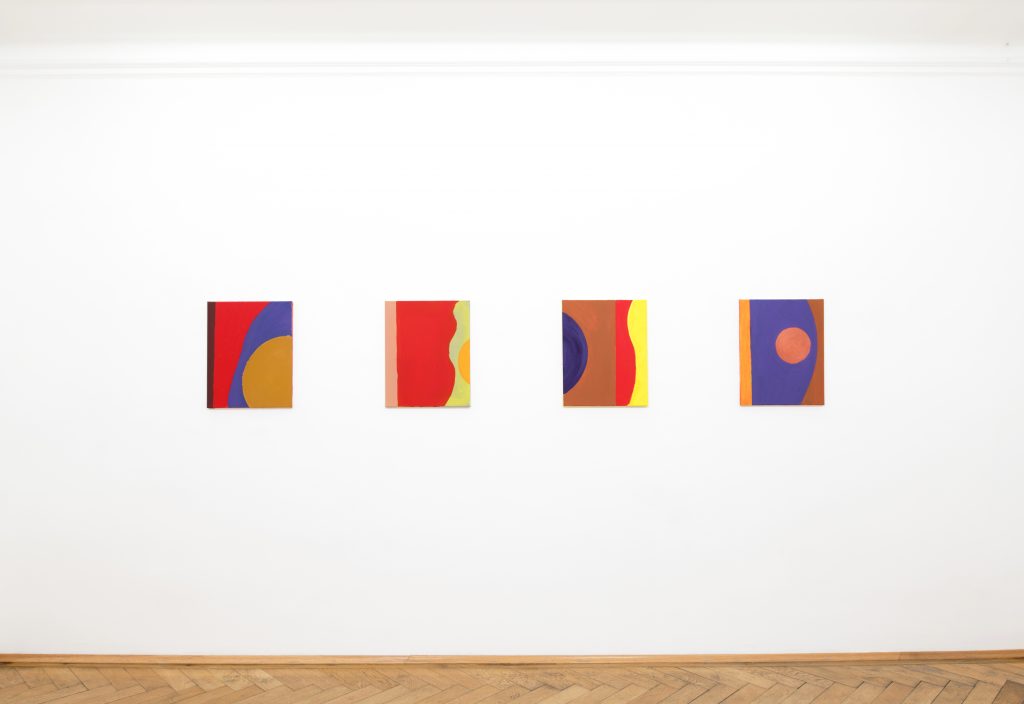
Installation view

Madame de Maintenant zeigt Red Diary, 2022
Wood, lacquer, tablet, 165 x 74 x 31 cm

Installation view

Nemesis 36, 2022
Oil on canvas, 50 x 40 cm

Nemesis 18, 2022
Oil on canvas, 70 x 50 cm

Installation view

Nemesis 5, 2022
Oil on canvas, 40 x 50 cm

Nemesis 19, 2020
Oil on canvas, 70 x 50 cm

Nemesis 32, 2021
Oil on canvas, 50 x 40 cm

Installation view

Nemesis 22, 2022
Oil on canvas, 50 x 40 cm

Nemesis 11, 2022
Oil on canvas, 50 x 40 cm

Nemesis 2, 2020
Oil on canvas, 50 x 40 cm

Nemesis 1, 2020
Oil on canvas, 50 x 40 cm

Nemesis 3, 2020
Oil on canvas, 50 x 40 cm

Nemesis 21, 2020
Oil on canvas, 50 x 40 cm

Nemesis 33, 2020
Oil on canvas, 50 x 40 cm

Installation view

Fächer, 2017
Glazed ceramics, 17,5 x 10 x 28 cm

Tulpe, 2017
Glazed ceramics, 10,5 x 10,5 x 40 cm

Venus, 2017
Glazed ceramics, 7 x 4,5 x 19 cm

Buch, 2017
Glazed ceramics, 10,5 x 5 x 18,5 cm

Was da kommen mag, 2017
Glazed ceramics, 15 x 10 x 11,5 cm
ANNE RÖSSNER
Madame de Maintenant
Nach Aristoteles kommt so gut wie nichts zustande ohne Aktivität. Ohne diese oder von selbst würde alles verfallen, altern, wir würden es am Ende vergessen. Aber der Zahn der Zeit ist nur scharf als das Jetzt, an dessen Stelle Madame de Maintenant tritt. Wie das Jetzt scheint die rote Silhouette, die Anne Rößners Red Diary trägt, zusammenzuhalten, was abgelaufen ist und was anrollt, den Zusammenhang in der Zeit erst zu bilden. Tagebuchschreiben, Malen und Modellieren sind Aktivitäten immer im Jetzt; in Madame de Maintenant scheint das Jetzt selber am Werk.
Denn Anne Rößners Red Diary bildet nur nominal oder als Buch einen Zusammenhang. Real sind die Texte, Zahlen und Bilder irgendwann zwischen 2015 und 2019 entstanden und scheinbar irgendwo in dem Buch platziert. In die Zeit zwischen 2020 und 2022 fallen die Ölbilder, die nicht wie Madame de Maintenant ein Stehen, sondern ein Drängen manifestieren. Drei horizontale Streifen aus verschiedenen Farben, von denen einer wellig begrenzt ist und eine vierte Farbe als Punkt oder Kreis werden zumeist um 90 Grad gedreht, als ob die Drehung im Umlauf um das Gestirn erfolgt. Lukrez hat gesagt, dass es ein Oben und Unten im Kosmos nicht gibt. Aristoteles fragt nach unbegrenzt oder begrenzt und sprengt diese Einteilung durch das Beispiel: Gemütszustand oder Punkt. Anne Rößner macht aus dem Punkt eine farbige Sonne und nennt ihre Serie, deren Farbskala sich von Gelb nach Violett bewegt und Blau und Grün sein lässt, Nemesis. So wie das Jetzt scheint auch das Verhängnis am Werk. Seit 30 Jahren hat Anne Rößner in Ton modelliert. 2017 hat sie eine Anzahl von Keramiken, die so verschieden sind wie Haus, Mensch, Vase, Pflanze, Sockel und Kleid rot glasiert und wie auf einem Forum versammelt. Eine davon erinnert an das Jetzt, das Sandro Botticelli als Geburt der Venus formuliert hat. Oder eine Figur, die im Stoff immer schon steckte, ist jetzt und endlich wirklich geworden.
Denn die Zeit, die Anne Rößner beschreibt, ist in einem weiteren Sinne gemeinsam als die Rede von unserer Zeit. Der Autor dieses Textes hat Madame de Maintenant ausgeschnitten und gefunden, was Kara Walker gesagt haben soll: Die Silhouette sagt viel mit sehr wenig Information. Lilian Robl hat das Red Diary aufgenommen. Anne Rößner kennt Francis Picabias Punkte und Etel Adnans Farben. Aber sie bringt nicht nur Serien hervor, die im Red Diary solche von Zahlen sein können; noch davor geht es ihr nicht nur um Namen, sondern um deren Reihe oder deren Versammlung wie auf einem Forum. Daher kommt der Antike in kaum einer Arbeit mehr Kraft aus der Gegenwart zu. 1939 lässt Arno Schmidt seinen Faun sagen, dass sein Leben kein Kontinuum sei. Und 347 vor Christus hört Aristoteles jemanden sagen, dass Koriskos im Lykeion ein anderer sei als Koriskos auf dem Markt. Gewiss hat der, den das Mittelalter den Philosophen nannte, das eine Verdrehung genannt. Aber ebenso gewiss lässt Anne Rößners Arbeit hellhörig werden für das, was schon beim Philosophen abweicht von dem, was Kant die Zeitordnung nennt.
Denn die Anordnung Madame de Maintenant zeigt Red Diary macht eine persönliche Aufzeichnung allgemein sichtbar und kehrt so eine Ordnung um, in der die Malerei untergeht in der Fotografie und diese im Algorithmus. Ein Situationismus kann darin bestehen, das eigene Betroffensein immer zu messen an dem, was Adorno Einstand nennt, „momentanes Innehalten des Prozesses, als der (das Kunstwerk) dem beharrlichen Auge sich offenbart.“ (Theodor W. Adorno, Ästhetische Theorie, Frankfurt am Main 1973, S. 17) Es füllt sich also die leere Zeit selbst, wenn Madame de Maintenant zu einer Ausstellung wird.
Berthold Reiß
ANNE RÖSSNER
Madame de Maintenant
According to Aristotle, almost nothing comes into existence without activity. Without it or simply on its own accord, everything would decay and age, we would eventually forget about it. But the ravages of time are fierce only in the Now where Madame de Maintenant takes place. Just like the Now, the red silhouette, carrying Anne Rößner’s Red Diary, brings together what has passed and what is about to come, consequently forming a connection in time. Diary keeping, painting, and moulding are always activities of the Now; in Madame de Maintenant the Now itself seems to be at work.
For Anne Rößner’s Red Diary forms a connection only nominally or in the form of a book. In reality, the texts, numbers, and images were created sometime between 2015 and 2019 and are seemingly placed at random in the book. The oil paintings, created between 2020 and 2022, do not manifest themselves as a standstill, like Madame de Maintenant, but as an urge. Three horizontal stripes of different colours, one of which has a wavy border and a dot or circle in a fourth colour, are mostly rotated 90 degrees as if this rotation occurs in an orbit around a celestial body. Lucretius said that there is no top and bottom in the cosmos. Aristotle interrogates the notion of un- or limited space and breaks this division with the following example: state of mind or dot. Anne Rößner turns the dot into a coloured sun and calls her series, whose colour scale moves from yellow to violet omitting blue and green colours, Nemesis. Just like the Now, fate seems to be also at work. Anne Rößner has been moulding clay for 30 years. In 2017, she glazed a number of ceramics red; these were as diverse as a house, a human, a vase, a plant, a base, and a dress, all brought together as if placed in a forum. One of them is reminiscent of the Now Sandro Botticelli formulated in the Birth of Venus. Or a figure, which has always existed as matter has finally become real.
For the time Anne Rößner describes is, in a broader sense, commonly referred to as the talk of our time. The author of this text has cut out Madame de Maintenant and found what Kara Walker is said to have said: the silhouette says a lot with very little information. Lilian Robl has recorded the Red Diary. Anne Rößner knows Francis Picabia’s dots and Etel Adnan’s colours. But she not only produces series, which in Red Diary can consist of numbers; prior to that, she is not only concerned with names, but with their sequence or their arrangement, similar to a forum. Therefore, in hardly any contemporary work does antiquity gain more presence. In 1939, Arno Schmidt had his faun say that his life was not a continuum. And in 347 BC, Aristotle hears someone say that Koriscus in the Lykeion is different from Koriscus in the Agora. Certainly, the one who was called the philosopher in the Middle Ages referred to this as a distortion. But just as certainly, Anne Rößner’s work makes us listen attentively to the moment already the philosopher diverges from what Kant called the order of time.
For the arrangement Madame de Maintenant zeigt Red Diary makes a personal record universally visible and thus reverses an order in which painting is lost in photography and consequently in the algorithm. A situationism can consist in always measuring one’s own concern against what Adorno called Einstand, “a suspended moment of the process, as which (the artwork) reveals itself to the unwavering eye” (Theodor W. Adorno, Aesthetic Theory, London 1997, p. 7). Empty time thus fills itself the moment Madame de Maintenant becomes an exhibition.
Berthold Reiß
Translated by Melanie Waha